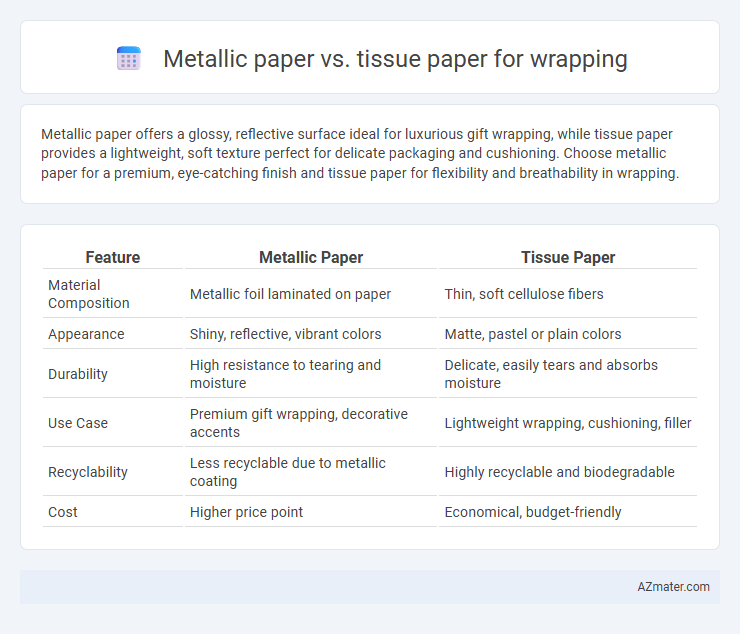Metallic paper offers a glossy, reflective surface ideal for luxurious gift wrapping, while tissue paper provides a lightweight, soft texture perfect for delicate packaging and cushioning. Choose metallic paper for a premium, eye-catching finish and tissue paper for flexibility and breathability in wrapping.
Table of Comparison
| Feature | Metallic Paper | Tissue Paper |
|---|---|---|
| Material Composition | Metallic foil laminated on paper | Thin, soft cellulose fibers |
| Appearance | Shiny, reflective, vibrant colors | Matte, pastel or plain colors |
| Durability | High resistance to tearing and moisture | Delicate, easily tears and absorbs moisture |
| Use Case | Premium gift wrapping, decorative accents | Lightweight wrapping, cushioning, filler |
| Recyclability | Less recyclable due to metallic coating | Highly recyclable and biodegradable |
| Cost | Higher price point | Economical, budget-friendly |
Introduction: Comparing Metallic Paper and Tissue Paper for Wrapping
Metallic paper offers a glossy, reflective finish that enhances the visual appeal and adds a luxurious touch to gift wrapping, making it ideal for special occasions. Tissue paper, known for its lightweight, translucent texture, provides a delicate and versatile wrapping option suitable for cushioning fragile items and layering inside gift bags. Both materials differ significantly in durability, aesthetic effect, and functional use, influencing the choice based on presentation and protection needs.
Material Composition and Structure
Metallic paper consists of a plastic film base coated with a thin layer of aluminum, providing a smooth, reflective surface that enhances durability and moisture resistance. Tissue paper is made from thin, lightweight cellulose fibers, resulting in a soft, porous texture that offers flexibility and breathability but less protection against moisture. The structural differences in fiber density and coating directly influence their suitability for wrapping, with metallic paper excelling in protective and decorative applications while tissue paper is preferred for delicate, lightweight packaging.
Visual Appeal and Aesthetic Differences
Metallic paper offers a shiny, reflective surface that enhances gift presentations with a vibrant, luxurious aesthetic, making it ideal for festive and elegant occasions. Tissue paper provides a soft, matte finish that conveys a delicate, understated charm while allowing for layering and color coordination to create depth and texture. The choice between metallic and tissue paper depends on whether the desired visual impact is bold shimmer or subtle sophistication.
Durability and Strength Factors
Metallic paper boasts superior durability and strength compared to tissue paper, making it ideal for wrapping delicate or heavy items. Its laminated surface provides resistance to tearing, moisture, and creasing, enhancing protection during handling and transport. In contrast, tissue paper is lightweight and less sturdy, prone to easily ripping and offering minimal protective strength for fragile packages.
Flexibility and Ease of Wrapping
Metallic paper offers moderate flexibility with a slightly stiff texture, making it ideal for structured and decorative wrapping styles, but it can be challenging to mold around intricate shapes. Tissue paper excels in softness and pliability, allowing for effortless wrapping of delicate or irregular objects with smooth folds and minimal creasing. The ease of handling tissue paper makes it a preferred choice for wrapping gifts that require gentle coverage and multiple layering.
Suitability for Various Gift Types
Metallic paper offers a glossy, luxurious finish ideal for formal or festive gifts such as jewelry, electronics, and holiday presents, enhancing visual appeal and perceived value. Tissue paper, with its lightweight and delicate texture, is better suited for fragile or lightweight items like clothing, scarves, and small accessories, providing cushioning while maintaining a soft, elegant look. Choosing between metallic and tissue paper depends on the gift's size, fragility, and the desired presentation style for the wrapping.
Eco-Friendliness and Sustainability
Metallic paper, often coated with plastic or aluminum, poses significant challenges for recycling and contributes to environmental pollution, making it less eco-friendly compared to tissue paper. Tissue paper, typically made from renewable resources and biodegradable materials, offers a sustainable wrapping option that breaks down naturally without leaving harmful residues. Choosing tissue paper supports reduced waste and a lower carbon footprint, aligning better with eco-conscious wrapping practices.
Cost Comparison and Affordability
Metallic paper typically costs more than tissue paper due to its specialty finish and production expenses, making it less affordable for large-scale wrapping projects. Tissue paper offers a budget-friendly option with sufficient durability and aesthetic appeal, especially for bulk purchases. Businesses and individuals seeking cost-effective wrapping solutions often prefer tissue paper to balance quality and affordability.
Popular Uses and Occasions
Metallic paper, known for its reflective sheen and durability, is popular for wrapping gifts during festive occasions such as Christmas, birthdays, and weddings, where a luxurious and eye-catching presentation is desired. Tissue paper, lightweight and soft, is commonly used for wrapping delicate items or as a decorative layer inside gift bags, making it ideal for baby showers, bridal showers, and party favors. Both materials serve specific aesthetic and functional purposes, with metallic paper enhancing visual impact and tissue paper offering a gentle touch and color variety.
Final Verdict: Which Wrapping Paper Should You Choose?
Metallic paper offers a glossy, eye-catching finish ideal for festive occasions, while tissue paper provides a lightweight, versatile option that is gentle on delicate items. Choose metallic paper for its durability and elegant appearance that enhances the unwrapping experience, whereas tissue paper is perfect for adding a soft touch and layering within gift bags or boxes. The final decision depends on your presentation goals, budget, and the nature of the gift you are wrapping.

Infographic: Metallic paper vs Tissue paper for Wrapping
 azmater.com
azmater.com